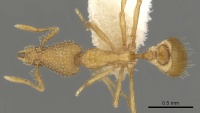Strumigenys exunca
| Strumigenys exunca | |
|---|---|

| |
| Scientific classification | |
| Kingdom: | Animalia |
| Phylum: | Arthropoda |
| Class: | Insecta |
| Order: | Hymenoptera |
| Family: | Formicidae |
| Subfamily: | Myrmicinae |
| Tribe: | Attini |
| Genus: | Strumigenys |
| Species: | S. exunca |
| Binomial name | |
| Strumigenys exunca (Bolton, 2000) | |
Nothing is known about the biology of Strumigenys exunca.
Identification
Bolton (2000) - A member of the emarginata complex in the Strumigenys emarginata group. Most closely related to the southern African Strumigenys robertsoni but distinguished by the reduced sculpture of the lateral alitrunk and numerous simple standing hairs close to the occipital margin that contrast strongly with the ground-pilosity.
Keys including this Species
Distribution
Distribution based on Regional Taxon Lists
Afrotropical Region: Cameroun (type locality), Ghana, Ivory Coast, Togo.
Distribution based on AntMaps
Distribution based on AntWeb specimens
Check data from AntWeb
Countries Occupied
| Number of countries occupied by this species based on AntWiki Regional Taxon Lists. In general, fewer countries occupied indicates a narrower range, while more countries indicates a more widespread species. |

|
Estimated Abundance
| Relative abundance based on number of AntMaps records per species (this species within the purple bar). Fewer records (to the left) indicates a less abundant/encountered species while more records (to the right) indicates more abundant/encountered species. |

|
Biology
|
Castes
Nomenclature
The following information is derived from Barry Bolton's Online Catalogue of the Ants of the World.
- exunca. Pyramica exunca Bolton, 2000: 302, figs. 202, 230 (w.) CAMEROUN. Combination in Strumigenys: Baroni Urbani & De Andrade, 2007: 120
Unless otherwise noted the text for the remainder of this section is reported from the publication that includes the original description.
Description
Worker
Holotype. TL 2.3, HL 0.65, HW 0.39, CI 60, ML 0.10, MI 15, SL 0.30, SI 77, PW 0.25, AL 0.64. Characters of emarginata-complex. With head in full-face view ground-pilosity of the dorsum of numerous small spoon-shaped hairs that are very conspicuous; these hairs slightly denser on the clypeal dorsum than elsewhere. Lateral margin of occipital lobe without projecting simple hairs but a n umber of curved spoon-shaped hairs may project beyond the outline. In profile the spoon-shaped ground-pilosity very distinct from clypeus to highest point of vertex but behind this with numerous finer simple hairs that are erect and weakly curved anteriorly, contrasting strongly with the ground-pilosity. Pronotal dorsum with distinct curved spoon-shaped hairs only. Mesonotum with very sparse spoon-shaped ground-pilosity and with 3-4 pairs of long standing hairs that are simple, slightly flattened or weakly remiform, and usually shallowly curved. Pleurae and side of propodeum with extensive smooth shining areas. Pronotal dorsum weakly sculptured, usually with faint longitudinal striae visible. Propodeal dorsum with vestiges of punctate sculpture.
Paratypes. TL 2.3-2.5, HL 0.64-0.70, HW 0.38-0.41, CI 59-61, ML 0.10-0.12, MI 15-18, SL 0.30-0.32, SI 77-80, PW 0.25-0.28, AL 0.64-0.70 (10 measured).
Type Material
Holotype worker, Cameroun: Pan Pan-Matamb, 70 km. S Yaounde, 10.xi.1988 (A. Dejean) (The Natural History Museum).
Paratypes. 10 workers with same data as holotype (BMNH, Museum of Comparative Zoology).
References
- Baroni Urbani, C. & De Andrade, M.L. 2007. The ant tribe Dacetini: limits and constituent genera, with descriptions of new species. Annali del Museo Civico di Storia Naturale “G. Doria”. 99:1-191.
- Bolton, B. 2000. The ant tribe Dacetini. Memoirs of the American Entomological Institute. 65:1-1028. (page 302, figs. 202, 230 worker described)
References based on Global Ant Biodiversity Informatics
- Bolton, B. 2000. The Ant Tribe Dacetini. Memoirs of the American Entomological Institute 65

